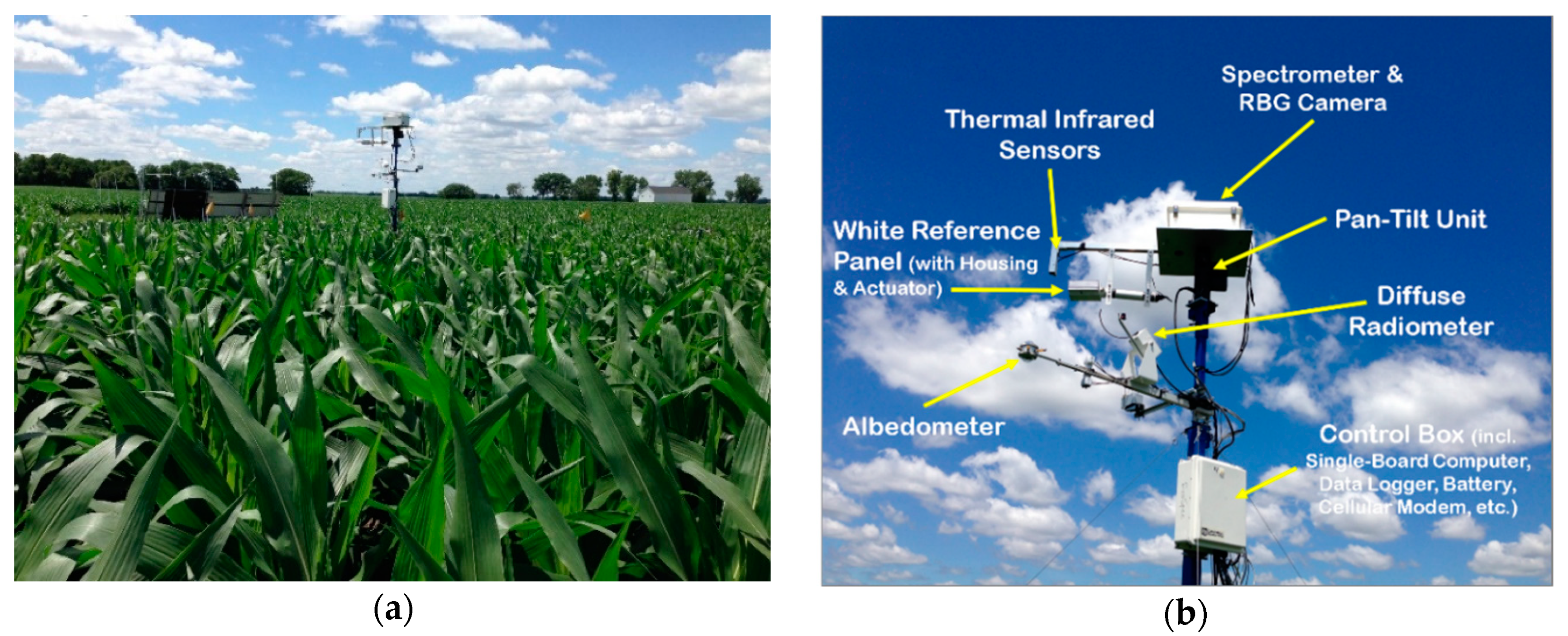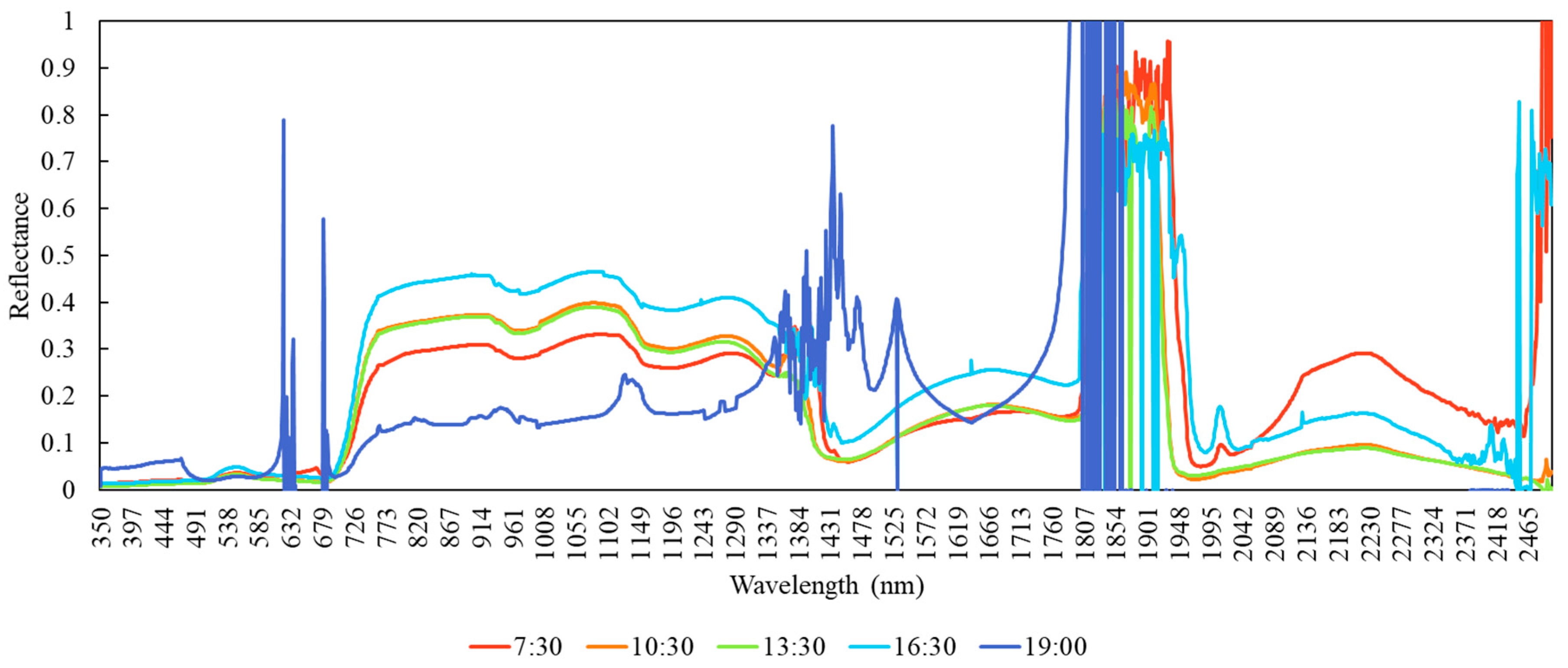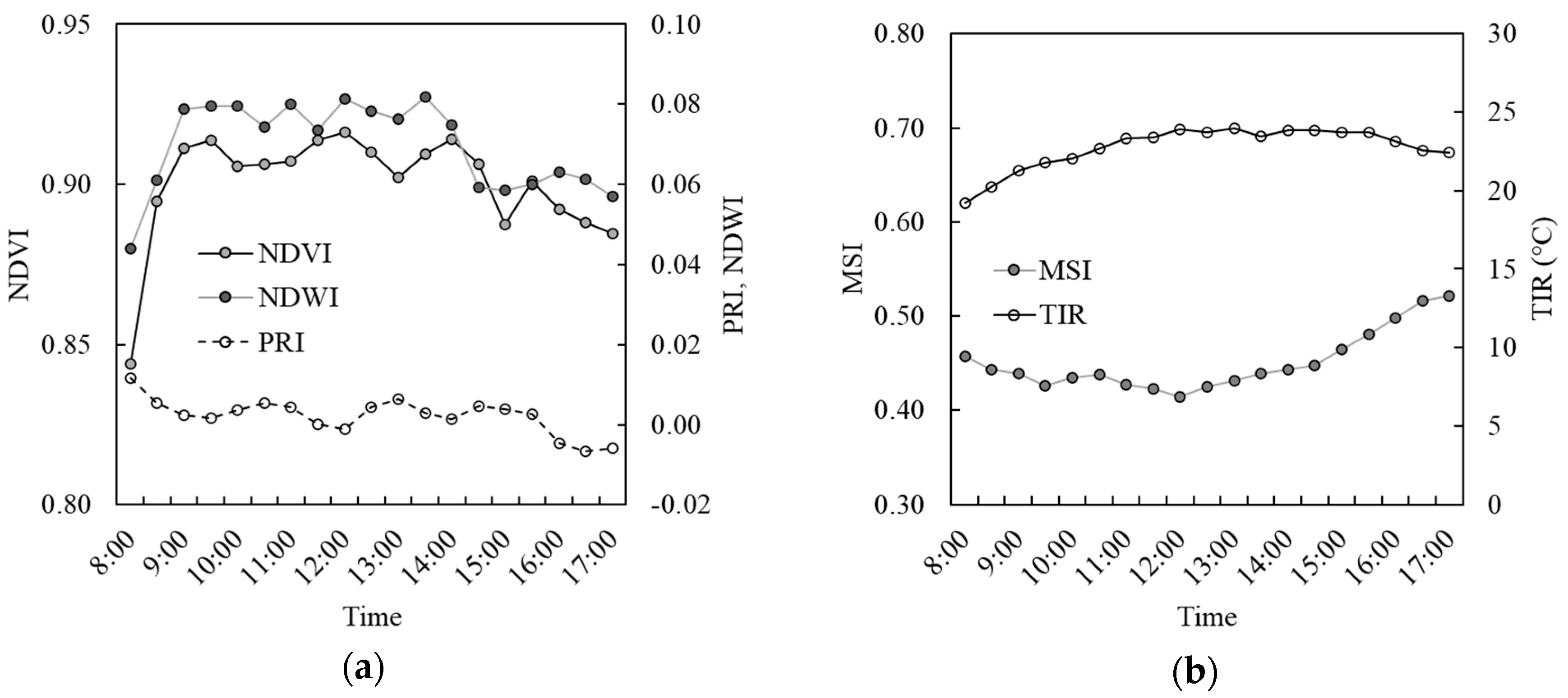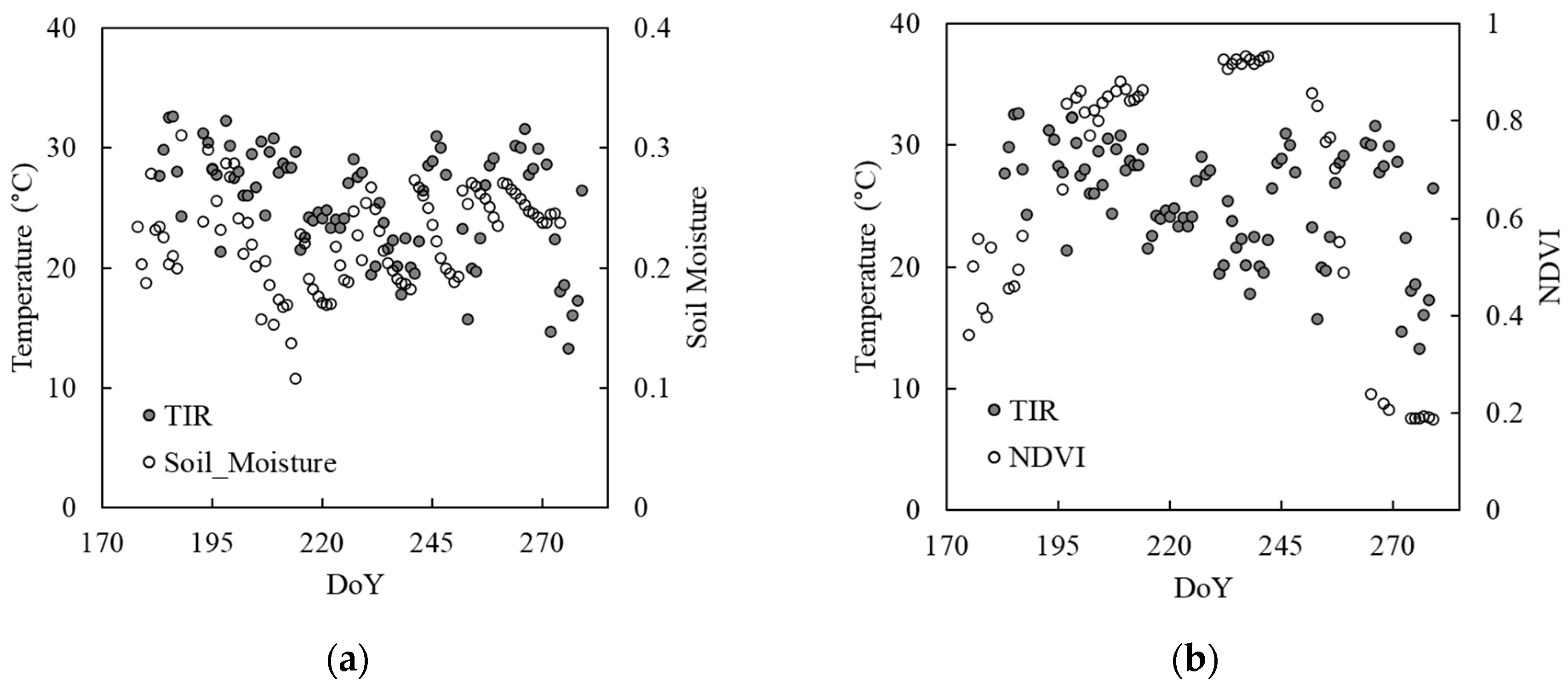EcoSpec: Highly Equipped Tower-Based Hyperspectral and Thermal Infrared Automatic Remote Sensing System for Investigating Plant Responses to Environmental Changes
Abstract
1. Introduction
2. Materials and Methods
2.1. Hardware and Physical Architecture
2.1.1. Upper Package
2.1.2. Lower Package
2.2. Software, Operation, and Data Collection and Management Design
2.3. Data Preparation
3. Results
4. Conclusions
- Collection of measurements from 12 locations spanning a 300 degree rotation of the platform to account for heterogeneity of the land surface.
- Integration of five optical and infrared sensors to collect a suite of measurements that complements hyperspectral reflectance measurements, enabling various modeling approaches, such as surface and sky temperature, direct and diffused sunlight, incoming and outgoing albedo, and RGB photos of the land surface.
- Custom software to control synchronized movements and functions of the system components so that every sensor collects measurements properly without interference of other sensors. This software manages a specific order or timing of actuator movement, reference reflectance measurement, target reflectance measurement, and platform movement in a compact package.
- Portability of the system as being powered by a relatively compact power generating system, such as the solar power system evaluated during the entire testing period, which allows for deployment at a range of sites, including existing research stations/observatories, short-term/temporary locations, remote locations, and agricultural fields.
Supplementary Materials
Author Contributions
Funding
Acknowledgments
Conflicts of Interest
References
- Battin, T.J.; Luyssaert, S.; Kaplan, L.A.; Aufdenkampe, A.K.; Richter, A.; Tranvik, L.J. The boundless carbon cycle. Nat. Geosci. 2009, 2, 598–600. [Google Scholar] [CrossRef]
- Bloom, A.A.; Exbrayat, J.F.; Van Der Velde, I.R.; Feng, L.; Williams, M. The decadal state of the terrestrial carbon cycle: Global retrievals of terrestrial carbon allocation, pools, and residence times. PNAS 2016, 113, 1285–1290. [Google Scholar] [CrossRef]
- Dixon, R.K. The global carbon cycle and global change: Responses and feedbacks from the mycorrhizosphere. In Mycorrhizal Biology; Springer: Boston, MA, USA, 2000; pp. 85–99. [Google Scholar] [CrossRef]
- Piao, S.; Sitch, S.; Ciais, P.; Friedlingstein, P.; Peylin, P.; Wang, X.; Ahlström, A.; Anav, A.; Canadell, J.G.; Cong, N.; et al. Evaluation of terrestrial carbon cycle models for their response to climate variability and to CO2 trends. Glob. Chang. Biol. 2013, 19, 2117–2132. [Google Scholar] [CrossRef]
- Xiao, J.; Chevallier, F.; Gomez, C.; Guanter, L.; Hicke, J.A.; Huete, A.R.; Ichii, K.; Ni, W.; Pang, Y.; Rahman, A.F.; et al. Remote sensing of the terrestrial carbon cycle: A review of advances over 50 years. Remote Sens. Environ. 2019, 233, 111383. [Google Scholar] [CrossRef]
- Gounand, I.; Little, C.J.; Harvey, E.; Altermatt, F. Cross-ecosystem carbon flows connecting ecosystems worldwide. Nat. Commun. 2018, 9, 1–8. [Google Scholar] [CrossRef]
- Ahmed, M.A.; Abd-Elrahman, A.; Escobedo, F.J.; Cropper, W.P., Jr.; Martin, T.A.; Timilsina, N. Spatially-explicit modeling of multi-scale drivers of aboveground forest biomass and water yield in watersheds of the Southeastern United States. J. Environ. Manag. 2017, 199, 58–71. [Google Scholar] [CrossRef] [PubMed]
- Piao, S.; Liu, Q.; Chen, A.; Janssens, I.A.; Fu, Y.; Dai, J.; Liu, L.; Lian, X.; Shen, M.; Zhu, X. Plant phenology and global climate change: Current progresses and challenges. Glob. Chang. Biol. 2019, 25, 1922–1940. [Google Scholar] [CrossRef]
- Garbulsky, M.F.; Peñuelas, J.; Gamon, J.; Inoue, Y.; Filella, I. The photochemical reflectance index (PRI) and the remote sensing of leaf, canopy and ecosystem radiation use efficiencies: A review and meta-analysis. Remote Sens. Environ. 2011, 115, 281–297. [Google Scholar] [CrossRef]
- Serbin, S.P.; Dillaway, D.N.; Kruger, E.L.; Townsend, P.A. Leaf optical properties reflect variation in photosynthetic metabolism and its sensitivity to temperature. J. Exp. Bot. 2012, 63, 489–502. [Google Scholar] [CrossRef] [PubMed]
- Fukumoto, R.; Borlongan, I.A.; Nishihara, G.N.; Endo, H.; Terada, R. Effect of photosynthetically active radiation and temperature on the photosynthesis of two heteromorphic life history stages of a temperate edible brown alga, Cladosiphon umezakii (Chordariaceae, Ectocarpales), from Japan. J. Appl. Phycol. 2019, 31, 1259–1270. [Google Scholar] [CrossRef]
- Shiklomanov, A.N.; Bradley, B.A.; Dahlin, K.M.; Fox, M.A.; Gough, C.M.; Hoffman, F.M.; Middleton, E.J.; Serbin, S.P.; Smallman, L.; Smith, W.K. Enhancing global change experiments through integration of remote-sensing techniques. Front. Ecol. Environ. 2019, 17, 215–224. [Google Scholar] [CrossRef]
- Gornish, E.S.; Prather, C.M. Foliar functional traits that predict plant biomass response to warming. Appl. Veg. Sci. 2014, 25, 919–927. [Google Scholar] [CrossRef]
- Sakowska, K.; Gianelle, D.; Zaldei, A.; MacArthur, A.; Carotenuto, F.; Miglietta, F.; Zampedri, R.; Cavagna, M.; Vescovo, L. WhiteRef: A new tower-based hyperspectral system for continuous reflectance measurements. Sensors 2015, 15, 1088–1105. [Google Scholar] [CrossRef] [PubMed]
- Mohammed, G.H.; Colombo, R.; Middleton, E.M.; Rascher, U.; van der Tol, C.; Nedbal, L.; Goulas, Y.; Perez-Priego, O.; Damm, A.; Meroni, M.; et al. Remote sensing of solar-induced chlorophyll fluorescence (SIF) in vegetation: 50 years of progress. Remote Sens. Environ. 2019, 231, 111177. [Google Scholar] [CrossRef]
- Yang, X.; Tang, J.; Mustard, J.F.; Lee, J.E.; Rossini, M.; Joiner, J.; Munger, J.W.; Kornfeld, A.; Richardson, A.D. Solar-induced chlorophyll fluorescence that correlates with canopy photosynthesis on diurnal and seasonal scales in a temperate deciduous forest. Geophys. Res. Lett. 2015, 42, 2977–2987. [Google Scholar] [CrossRef]
- Grossmann, K.; Frankenberg, C.; Magney, T.S.; Hurlock, S.C.; Seibt, U.; Stutz, J. PhotoSpec: A new instrument to measure spatially distributed red and far-red Solar-Induced Chlorophyll Fluorescence. Remote Sens. Environ. 2018, 216, 311–327. [Google Scholar] [CrossRef]
- Yang, X.; Shi, H.; Stovall, A.; Guan, K.; Miao, G.; Zhang, Y.; Zhang, Y.; Xiao, X.; Ryu, Y.; Lee, J.E. FluoSpec 2—An automated field spectroscopy system to monitor canopy solar-induced fluorescence. Sensors 2018, 18, 2063. [Google Scholar] [CrossRef]
- Gerhards, M.; Schlerf, M.; Mallick, K.; Udelhoven, T. Challenges and future perspectives of multi-/Hyperspectral thermal infrared remote sensing for crop water-stress detection: A review. Remote Sens. 2019, 11, 1240. [Google Scholar] [CrossRef]
- Mangus, D.L.; Sharda, A.; Zhang, N. Development and evaluation of thermal infrared imaging system for high spatial and temporal resolution crop water stress monitoring of corn within a greenhouse. Comput. Electron. Agric. 2016, 121, 149–159. [Google Scholar] [CrossRef]
- Tucker, C.J. Red and photographic infrared linear combinations for monitoring vegetation. Remote Sens. Environ. 1979, 8, 127–150. [Google Scholar] [CrossRef]
- Tucker, C.J.; Choudhury, B.J. Satellite remote sensing of drought conditions. Remote Sens. Environ. 1987, 23, 243–251. [Google Scholar] [CrossRef]
- Gao, B.C. NDWI—A normalized difference water index for remote sensing of vegetation liquid water from space. Remote Sens. Environ. 1996, 58, 257–266. [Google Scholar] [CrossRef]
- Gamon, J.A.; Penuelas, J.; Field, C.B. A narrow-waveband spectral index that tracks diurnal changes in photosynthetic efficiency. Remote Sens. Environ. 1992, 41, 35–44. [Google Scholar] [CrossRef]
- Hunt, E.R., Jr.; Rock, B.N. Detection of changes in leaf water content using near-and middle-infrared reflectances. Remote Sens. Environ. 1989, 30, 43–54. [Google Scholar] [CrossRef]
- Cho, M.A.; Skidmore, A.; Corsi, F.; Van Wieren, S.E.; Sobhan, I. Estimation of green grass/herb biomass from airborne hyperspectral imagery using spectral indices and partial least squares regression. Int. J. Appl. Earth Obs. 2007, 9, 414–424. [Google Scholar] [CrossRef]
- Mutanga, O.; Skidmore, A.K. Narrow band vegetation indices overcome the saturation problem in biomass estimation. Int. J. Remote Sens. 2004, 25, 3999–4014. [Google Scholar] [CrossRef]
- Jackson, T.J.; Chen, D.; Cosh, M.; Li, F.; Anderson, M.; Walthall, C.; Doriaswamy, P.; Hunt, E.R. Vegetation water content mapping using Landsat data derived normalized difference water index for corn and soybeans. Remote Sens. Environ. 2004, 92, 475–482. [Google Scholar] [CrossRef]
- Dennison, P.E.; Roberts, D.A.; Peterson, S.H.; Rechel, J. Use of normalized difference water index for monitoring live fuel moisture. Int. J. Remote Sens. 2005, 26, 1035–1042. [Google Scholar] [CrossRef]
- Marino, E.; Yebra, M.; Guillén-Climent, M.; Algeet, N.; Tomé, J.L.; Madrigal, J.; Guijarro, M.; Hernando, C. Investigating Live Fuel Moisture Content Estimation in Fire-Prone Shrubland from Remote Sensing Using Empirical Modelling and RTM Simulations. Remote Sens. 2020, 12, 2251. [Google Scholar] [CrossRef]
- Danson, F.M.; Bowyer, P. Estimating live fuel moisture content from remotely sensed reflectance. Remote Sens. Environ. 2004, 92, 309–321. [Google Scholar] [CrossRef]
- Gerhards, M.; Rock, G.; Schlerf, M.; Udelhoven, T. Water stress detection in potato plants using leaf temperature, emissivity, and reflectance. Int. J. Appl. Earth Obs. 2016, 53, 27–39. [Google Scholar] [CrossRef]
- Srinet, R.; Nandy, S.; Patel, N.R. Estimating leaf area index and light extinction coefficient using Random Forest regression algorithm in a tropical moist deciduous forest, India. Ecol. Inform. 2019, 52, 94–102. [Google Scholar] [CrossRef]
- Jones, H.G.; Serraj, R.; Loveys, B.R.; Xiong, L.; Wheaton, A.; Price, A.H. Thermal infrared imaging of crop canopies for the remote diagnosis and quantification of plant responses to water stress in the field. Funct. Plant. Biol. 2009, 36, 978–989. [Google Scholar] [CrossRef] [PubMed]
- Sellers, P.J.; Mintz, Y.C.S.Y.; Sud, Y.E.A.; Dalcher, A. A simple biosphere model (SiB) for use within general circulation models. J. Atmos. Sci. 1986, 43, 505–531. [Google Scholar] [CrossRef]
- Melillo, J.M.; McGuire, A.D.; Kicklighter, D.W.; Moore, B.; Vorosmarty, C.J.; Schloss, A.L. Global climate change and terrestrial net primary production. Nature 1993, 363, 234–240. [Google Scholar] [CrossRef]
- Hu, L.; Fan, W.; Ren, H.; Liu, S.; Cui, Y.; Zhao, P. Spatiotemporal dynamics in vegetation GPP over the great khingan mountains using GLASS products from 1982 to 2015. Remote Sens. 2018, 10, 488. [Google Scholar] [CrossRef]






| Instrument (Model, Manufacture) | Description |
|---|---|
| Spectrometer (ASDFieldSpec4 Std-Res, Malvern Panalytical; Cambridge, UK) | Spectral reflectance of land surface using 2150 spectral channels ranging from 350 to 2500 nm. Instrument with a 1.5 m fiber optic cable having a 25 degree field of view (FOV). Height of installation: 3–7 m above ground. Variables: Spectral reflectance (350–2500 nm) and spectral vegetation indices. 1 Frequency of measurement: ~1 min 2. |
| Thermal IR sensor (SI-111, Apogee Instruments Inc.; Logan, KY, USA) | Radiant temperature of canopy and ground surface. Height of installation: 3–7 m above ground. Variables: Surface temperature (plants and exposed soil) and sky temperature. Frequency of measurement: 1 min. |
| Red-green-blue (RGB) camera (Q1604, Axis; Lund, Sweden) | Plant conditions; visual and contextual information within the field of view of the spectrometer and its surroundings. Height of installation: 3–7 m above ground. Variable: Contexture information of land surface, such as plant conditions and land cover composition and structure. Frequency of measurement: 1 min. |
| Diffuse radiometer (RSR2, Irradiance Inc.; Cambridge, MA, USA) | Components of incoming light, such as direct and diffused light (2–6 m above ground). Variables: Total incoming light, direct light, sky light, sky temperature, and air temperature. Frequency of measurement: 1 min. |
| Albedometer (Dual-Pyranometer 8104, Schenk; Grass Valley, CA, USA) | Albedo of incoming and outgoing light. Height of installation: 2–6 m above ground. Variables: Downwelling irradiance and upwelling irradiance. Frequency of measurement: 1 min. |
| Pan-tilt unit (PTU-D300, FLIR; Wilsonville, AL, USA) | Rotating platform for the upper package, including spectrometer, thermal IR sensor, and RGB camera, in order to collect measurements at 12 positions around the tower (300°). Payloads: 70 lbs. |
| Enclosure (ENC 14/16-MM-NC, Campbell Scientific Inc.; Logan, KY, USA) | House spectrometer and RGB camera. |
| Actuator (PA-15-8-11, Progressive Automations; Arlington, TX, USA) | Extend and retract the white reference panel to enable white reference measurement right before each measurement from land surface. |
| White reference panel (Spectraron, Labsphere; North Sutton, NH, USA) | Provide a reference surface for white reflectance calibration. The highly reflective surface has 99% reflectivity across the spectral range. |
| Single-board computers (Raspberry Pi) | Provide commands to all system components and temporary data storage. |
| DC/AC converter | Convert DC power from the solar power system to AC to power the instruments. |
| Enclosure (Campbell Scientific Inc.; Logan, KY, USA) | House single-board computer, CR1000 data logger, and cellular modem. |
© 2020 by the authors. Licensee MDPI, Basel, Switzerland. This article is an open access article distributed under the terms and conditions of the Creative Commons Attribution (CC BY) license (http://creativecommons.org/licenses/by/4.0/).
Share and Cite
Hamada, Y.; Cook, D.; Bales, D. EcoSpec: Highly Equipped Tower-Based Hyperspectral and Thermal Infrared Automatic Remote Sensing System for Investigating Plant Responses to Environmental Changes. Sensors 2020, 20, 5463. https://doi.org/10.3390/s20195463
Hamada Y, Cook D, Bales D. EcoSpec: Highly Equipped Tower-Based Hyperspectral and Thermal Infrared Automatic Remote Sensing System for Investigating Plant Responses to Environmental Changes. Sensors. 2020; 20(19):5463. https://doi.org/10.3390/s20195463
Chicago/Turabian StyleHamada, Yuki, David Cook, and Donald Bales. 2020. "EcoSpec: Highly Equipped Tower-Based Hyperspectral and Thermal Infrared Automatic Remote Sensing System for Investigating Plant Responses to Environmental Changes" Sensors 20, no. 19: 5463. https://doi.org/10.3390/s20195463
APA StyleHamada, Y., Cook, D., & Bales, D. (2020). EcoSpec: Highly Equipped Tower-Based Hyperspectral and Thermal Infrared Automatic Remote Sensing System for Investigating Plant Responses to Environmental Changes. Sensors, 20(19), 5463. https://doi.org/10.3390/s20195463





